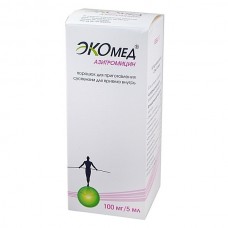Expiration date: 01/2026
Form release
Powder for preparing the suspension for oral administration.
Composition
5 ml suspension (one dosage spoon) contains:
Active substance: azithromycin dihydrate (in terms of azithromycin) - 100 or 200 mg.
Packaging
Bottle 16, 5 g.
Pharmacological action
Ekomed - antibacterial broad-spectrum drugs from the macrolides-azalides, acts bacteriostatic. Binding to 50S ribosome subunit, inhibits peptidtranslokazu on the stage of the translation, inhibits protein synthesis and slows the growth and reproduction of bacteria in high concentrations has a bactericidal effect. Acts on out-and intracellularly located pathogens. Microorganisms can be initially resistant to the action of an antibiotic or can acquire resistance to it.
Indications
Infectious and inflammatory diseases caused by microorganisms sensitive to the drug:
- infections of the upper respiratory tract and ENT organs: pharyngitis, tonsillitis, sinusitis, otitis media,
- infections of the lower respiratory tract: acute bronchitis, exacerbation of chronic bronchitis, pneumonia, including caused by atypical pathogens,
- infections of the skin and soft tissues: common acne of moderate severity, erysipelas, impetigo, secondary infected dermatoses,
- the initial stage of Lyme disease (borreliosis) - migratory erythema (erythema migrans),
- genitourinary tract infections caused by Chlamydia trachomatis (urethritis, cervicitis).
Contraindications
- Hypersensitivity to antibiotics of macrolides group,
- severe hepatic and/or renal failure,
- breast feeding,
- simultaneous administration with ergotamine and dihydroergotamine.
Caution: moderate impairment of liver and kidney function, arrhythmias or predisposition to arrhythmias and prolongation of the Qt interval, with the joint use of terfenadine, warfarin, digoxin.
Application during pregnancy and breast-feeding
Azithromycin in pregnancy is recommended to appoint only in cases where the expected benefit of its reception for the mother exceeds the potential risk to the fetus. During treatment with azithromycin, breastfeeding is suspended.
Method of application and doses
Children with 6 months, as a suspension for oral administration, ekomed appointed at the rate of 10 mg / kg 1 every day for 3 days or 5 day course:
on the first day - 10 mg/kg, then 4 days - 5-10 mg/kg/day (course dose - 30 mg/kg).
In Lyme disease (borreliosis) for the treatment of stage I (erythema migrans) in children dose - 20 mg/kg on the first day and 10 mg/kg from 2 to 5 day of the disease.
Side effect
From the digestive system: nausea, vomiting, diarrhea, abdominal pain, liquid stool, flatulence, digestive disorder, anorexia, constipation, changes in the color of the tongue, pseudomembranous colitis, cholestatic jaundice, hepatitis, changes in laboratory parameters of liver function, liver failure, liver necrosis (possibly fatal).
Allergic reactions: itching, skin rashes, angioedema, urticaria, photosensibilization, anaphylactic reaction (rarely fatal), erythema multiforme, Stevens-Johnson syndrome, toxic epidermal necrolysis.
From the side of cardiovascular system: a feeling of palpitations, arrhythmia, ventricular tachycardia, increased QT interval, bi-directional ventricular tachycardia.
From the Central nervous system: dizziness / vertigo, headache, convulsions, drowsiness, paresthesia, asthenia, insomnia, hyperactivity, aggression, anxiety, nervousness.
From the sensory organs: tinnitus, reversible hearing loss until deafness (when taking high doses for a long time), violation perception of taste and smell.
From the circulatory and lymphatic systems: thrombocytopenia, neutropenia, eosinophilia.
From the side of musculoskeletal system: arthralgia.
From the genitourinary system: interstitial nephritis, acute renal failure.
Other: vaginitis, candidiasis.
Special instruction
In case of missing the antibiotic, the missed dose should be taken as soon as possible, the next dose should be taken at intervals of 24 hours.
After the withdrawal of azithromycin therapy, hypersensitivity reactions in some patients may persist for a long time and may require specific therapy under the supervision of a physician.
Influence on the ability to drive vehicles and other mechanisms requiring increased concentration of attention
Given the likelihood of side effects from the Central nervous system, caution should be exercised when driving and operating machinery.
Drug interaction
Antacids do not affect the bioavailability of azithromycin, but reduce the maximum concentration in the blood by 30 %, so the drug should be taken at least one hour before or two hours after taking these drugs and food.
For parenteral administration the azithromycin does not affect the concentration of cimetidine, efavirenz, fluconazole, indinavir, midazolam, triazolam, co-trimoxazole in plasma in a joint application, but one should not exclude the possibility of such interactions in the appointment of azithromycin.
If necessary, combined with cyclosporine, it is recommended to monitor the content of cyclosporine in the blood.
When taking digoxin and azithromycin together, it is necessary to control the concentration of digoxin in the blood, because many macrolides increase the absorption of digoxin in the intestine, thereby increasing its concentration in blood plasma.
If necessary, a joint reception with warfarin is recommended to conduct a thorough control of prothrombin time.
Simultaneous administration of terfenadine and antibiotics of macrolide class causes arrhythmia and prolongation OF Qt interval. Based on this, it is impossible to exclude the above complications in the joint administration of terfenadine and azithromycin.
Because of the possibility of inhibition of CYP3A4 azithromycin in parenteral form when used together with cyclosporine, terfenadine, ergot alkaloids, cisapride, pimozide, quinidine, astemizole and other drugs, metabolism which takes place with participation of this isoenzyme, should consider such interaction in the appointment of azithromycin.
When concomitant intake of azithromycin and zidovudine, azithromycin does not affect the pharmacokinetic parameters of zidovudine in the blood plasma or the excretion of his kidneys and his glucuronated metabolite. Nevertheless, the concentration of active metabolite - phosphorylated zidovudine in mononuclear cells of peripheral vessels increases. The clinical significance of this fact is not clear.
While taking macrolides with ergotamine and dihydroergotamine may be a manifestation of their toxic effects.
Overdose
Symptoms: temporary hearing loss, nausea, vomiting, diarrhea.
Treatment: symptomatic.
Storage conditions
Store in a dry, dark place at a temperature not exceeding 25 °C.
The finished suspension is stored at a temperature of 2 ºC to 8 ºC in a tightly closed bottle.
Shelf life
2 years.
Willing suspension of 5 days.



